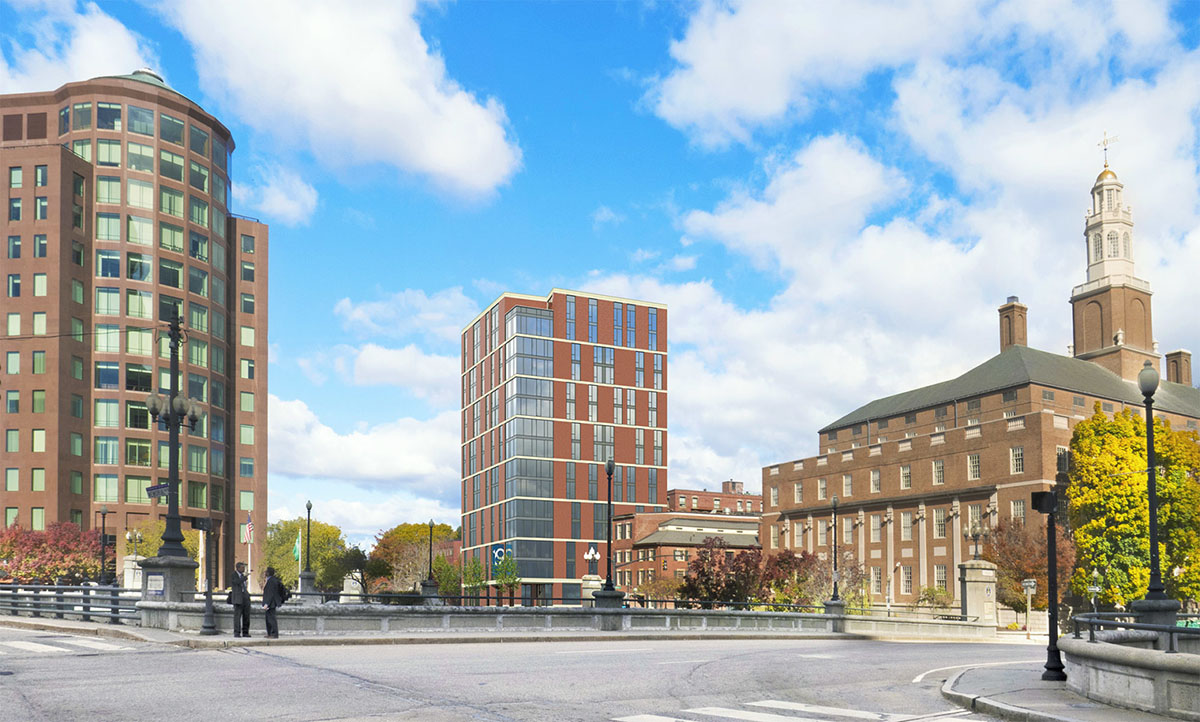
View from Memorial Blvd. at Washington St., 169 Canal at center.
Press Release from DBVW Architects:
DBVW Architects is working closely with Vision Properties on Edge College Hill, a new mixed-use residential project in downtown Providence at the base of College Hill. Located at 169 Canal Street, this new 15-story high-rise will include 202 micro-loft style apartments and first floor commercial space. Amenities for the residential units include a top floor common room and southwest facing terrace as well as a fitness center and first floor lobby/gathering space.
These modernly furnished apartments will primarily be marketed towards students. Features include over-sized windows, high-end finishes, 9′ 7″ ceilings, fully equipped kitchens and fold-down beds that tuck into contemporary cabinetry when not in use. Residents will be able to choose from views of the Providence skyline, historic College Hill, and the Rhode Island State House.
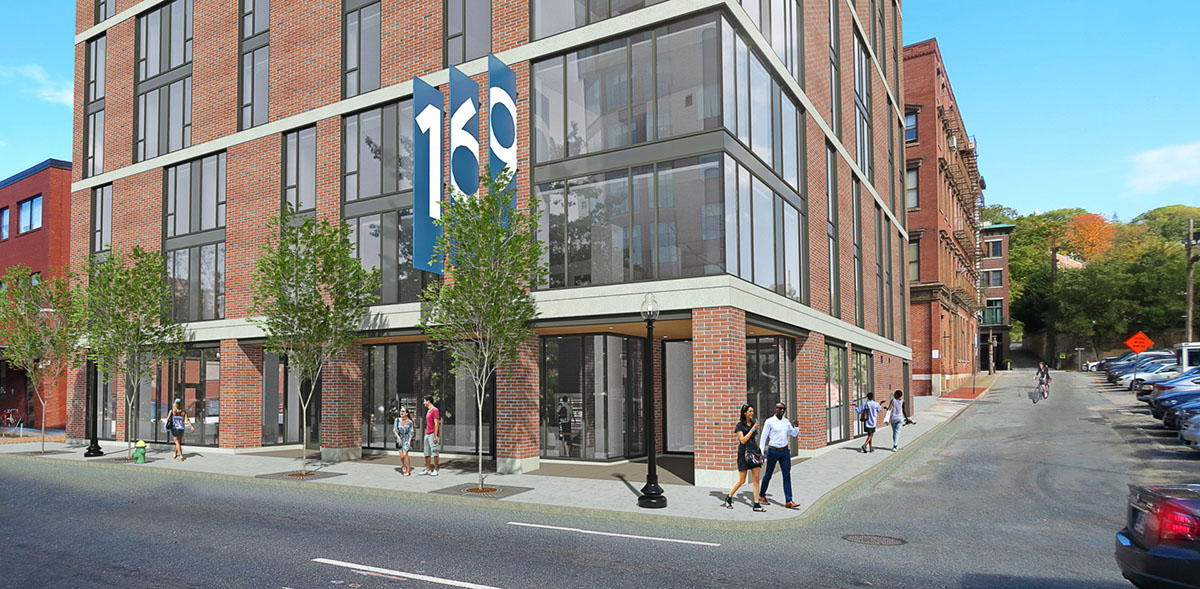
Street level view.
169 Canal Street, formerly a surface parking lot, is a long vacant parcel of land that fronts the highly acclaimed Providence River Walk. When completed, this urban, car-free development will play an important role in fostering a more walkable and livable city. In addition to adding significantly to the number of residents living downtown, the project will encourage new businesses such as restaurants and markets to join Providence’s already exciting growth.
Construction of Edge College Hill is underway and completion is scheduled for summer 2018.

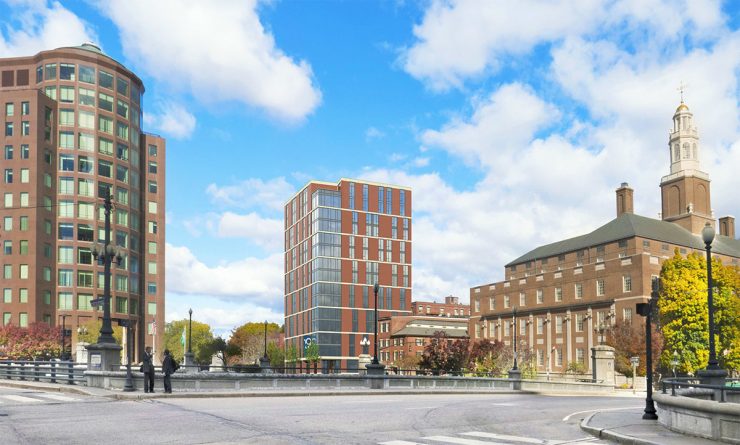
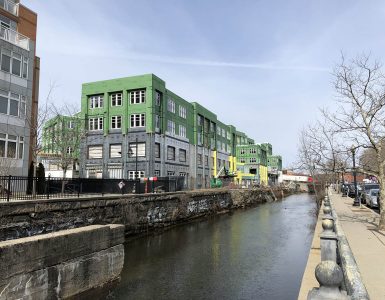
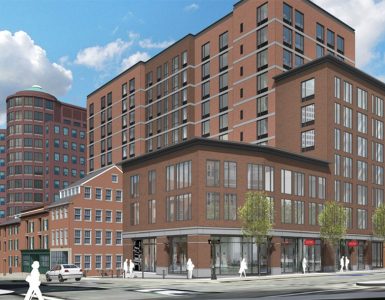
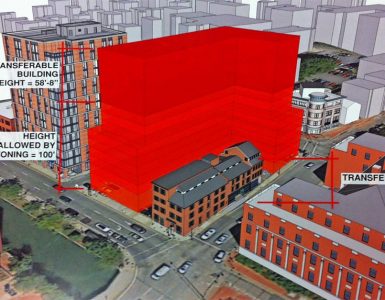

Who is the contractor or construction manager?
A tall building being constructed with no parking!? Be still, my heart!
I love this. The tower crane is being assembled now, and it’s going to be a really tall one.
This new building will be connected to or use space in the neighboring Elizabeth building, is that correct?
In other news, the parking lot next to the South Street Landing project is now fenced off so it looks like we may see some action there soon too for the student housing project
Love driving around downtown and seeing construction left and right, this site is looking good with the crane assembly, but that triangle lot hotel is bothering me, no action in almost two months.
More evidence that downtown is being abandoned as a business center. Having a corpse (the Superman building )in the middle of the city not a good thing, and it will never be redeveloped in any way that makes sense economically. We should start call this former “downtown” the city center residential district. This new building si a good thing.
Why not have the Fain High Rise go where 110 Wrstminister was proposed to go?
So many residential units being added again 🙂 saw the projo article about Buff Chase refurbishing 3 more buildings for mixed residential/commercial use as well. Dorrance st. Just added the G reserve and micro lofts are also coming between that and the G.
Speaking of Superman, I find it really strange that we have heard nothing since BOA and High Rock settled their lawsuit. Meanwhile, Gina is giving free college tuition and not focusing on landmark projects that could change the capital city forever. Why is the State not committing resources to reaching a deal on the Industrial Trust apartment development? It is inexcusable. Tax stabilization programs are not free money — they are an incentive to stimulate economic development.
Superman would be a ~275? apartment building with no parking, located directly downtown. The influx of new residents and new retail on the ground level would help to clean up KP. More people walking dogs, sitting outside at restaurants and cafes, more activity on the RiverWalk, more people shopping, etc. — it would be a game changer for downtown Providence. Not to mention a high rise, fully lit building on our skyline.
Providence could absorb many residential projects the size of Edge College Hill without a problem. The City (and State) needs to support the developers that are proposing these projects with the tax stabilization they need to break ground and add these units to the tax roles. We are in the 8th year of a capital markets bull run, we need to get developers breaking ground when the environment is stable — this should be a priority.
Recently, I was walking to try out the new aussie inspired cafe near the train station called Sydney, and I was looking at the surface parking lots behind the Citizens Bank building. This is PRIME real estate to develop into high rise apartments. #1. close proximity to the train station and bus hub, #2. it activates the street from Memorial Blvd up to the train station and bus hub, #3. it is already surrounded by high rises, #4. creates greater density around Waterplace Park. They could easily put two large residential high rises on this property — another 400 units would change this area of the city and provide more Boston commuters an alternative. Edge and Commons@Prov. Station are close to this lot, as well as the existing Avalon @ Center Place. This creates an even denser community of commuters close to Providence Station, and probably makes Providence more attractive to businesses looking to relocate.
The second area that would be perfect for a large-scale residential (or mixed-use) development would be Victory Place. If this area opened up primarily to Point Street (have to figure out the traffic pattern) it would be far more aesthetically pleasing than the Eddy Street side. I know the hospital purchased this land, I am not sure if it was defense to prevent the PawSox from using it as an alternative, or they really do intend on developing additional facilities on the other side of the highway — but I hope that any development by the hospital would stay on the South Side of the highway. Adding more density in this area of the city would create more foot traffic between the south and north sides of downtown, and in combination with the Fane building and innovation district there could be a lot going on in this area…not to mention proximity to Wickenden.
You seem to be endorsing the abandonment of downtown Providence as a business center? Is this true. If it is, is this really wise for long term development and enhanced tax revenues? Providence is stuck in a cycle of mediocre residential building developments. What are the tax revevnue data really on these new residences?
You also do not address the enormous costs of doing any kind of rehabbing of teh Suoparman Building. Cost estimates on tehse old buildings skyrocket as the projecty proceeds.
And just how rescuable is the Superman building? The facade is limestone, the very worst material to use for maintenance. Right now the limestone cladding is breaking up and developing serious mold problems. Private developers do not want to touch this project because the costs would be so high that the units, as you describe them ,would be to costly for the micro-apartment market. The state would be stuck with constantly rising bills as it faces the real possibility of the loss of, or reduction of, federal subsidies. The state is 30% dependent on federal money, tax revenue in RI are not great, and there are serious restrictions on how the federal subsidies can be used, especially for building purposes.
Providence already has a large inventory of preserved historic property, including in downtown the Merchants Bank building, the Federal Reserve bank building, the Arcade, City Hall, The Federal Building, and other properties very near to the Superman Building. Meanwhile Providence lacks any inspiring and innovative modern architecture, such as the Freedom Tower in New York or the garden commercial and residential buildings in Europe, Japan and Australia, to name a few countries. The only way or get a non-mediocre innovative design is to sponsor a world wide competition among architects. This could be done for any new building proposed for the current Supeman site (after that building is demolished). A process involving a worldwide competition would make developing the site far more attractive to private investment.
New England,especially RI, seems to have a nostalgia problem, a problem with living in the past, a sure sign of resignation to economic decline. The developers of the Superman building were looking to the future, not the past, when they built that building.. So too the developers of the Arcade. RI needs to be future oriented, as it used to be in the past.
Another huge nostalgia problem around here is public broadcasting. Instead of an endless stream of “This Old House” projects there needs to be a prograrm focusing on the developing of modern structures , including commercial skyscrapers,that are energy efficient or energy self-supplying, ecologically healthy, and ready for full use of modern materials (unlike dreadfully wastefull limestone) and modern technology.
I also do not see why I would have to subsidize the price of an apartment for a basically privileged group. I have no problem using tax money for the common good. Subdsizing the price of apartments that are not targeted to low income people is not my idea of spending for the common good. I am tired of America’s habit of passing the losses onto government while passing the profits on to private investors..
The Superman Building, if it is not torn down, will still be empty ten years form now, a rotting corpse in teh middle of the city. A feng shui expert form Hong King would be appalled that Providence is centered on a corpse.
with all these tax breaks Im sure these builders are getting :: what are we getting in return NOTHING a bunch of new buildings when we have a bunch of empty old beautiful buildings in the city already that just need some lipstick and mascara :: the city is short on parking spaces now and with all the scheduled construction in the fucture the builders are not going to lose square footage in profits for parking spots because they don’t care about the community’s impact on parking shortages what’s next a trolley car system so we as tax payers will foot the bill bonds or something else the politicians get there you no the dirty word or what ever the builders get richer and RI ers Foot all the bills in the end
What?
“You seem to be endorsing the abandonment of downtown Providence as a business center?” — No, I never said that. In fact, I don’t think I mentioned anything about the financial district at all other than the Superman project — which has already been proposed by the developer as a residential conversion.
You are talking about things that, on the surface, I do not disagree with. However, you can’t force a business to relocate — so for the time being, office space in Providence is a dead market (except for the handful of companies getting tax deals to relocate). If we want to attract businesses, we need a downtown where people work, play, and LIVE. If we build this, they will come.
It is extremely shortsighted to turn down development because you read about an edgy, innovative project in some other city 5,000 miles away. I’d much rather be part of the discussion on what I like (and dislike) about a proposal, with hopes that community feedback will get the developer to alter his proposal slightly.
The discussion in Rhode Island is entirely one sided: hstoric preservation is absolute doctrine and any alternative cannot be entertained. The people of Rhode Island are owed alternative ideas. The fact is that any rehab of the Superman Building is economically not viable. Deliberately low estimates of costs are being used. The structure of the building, interior and exterior, makes repurposing near impossible. The developer is not asking merely for tax breaks, but for a huge donation of money from the state. Thus the state will bear the majority of the costs, and the developer will reap all the profits. There reas0ns all the “plans” for this building go nowhere. They are not viable.
The building will go on as a rotting corpse. Worse, the economic development office will probably show this derelict place as the first choice for any large company considering relocation t RI.. The {PayPal visit was an act of madness, showing an obsolete building totally unsuited to the electrical needs of a modern tech company that would require, as they are called, a smart building, not something designed for businesses of the mid-20th century. I have no idea wha the PayPal CEO was thinking after that tour but if I were him I’d conclude that people in RI have idea of what my business about and that this would an entirely inappropriate state to work with, a state determined to live in the past.
Great points. My only concern with the comments here is the “RI” frame of reference.
While the big incentives come through state government, the focus of a relocation decision is primarily on the site, city, immediate area employee demographics, and city taxes.
These decisions are and will be PROVIDENCE based – not “RI”. Just like in Boston.
So, the city and state governments must focus on creating the conditions that will attract new large businesses…and then population growth with its buildings will follow.
The reference ids RI on finance because the city has not much money to do anything That’s the only reason.
John have you ever been inside the super man? It’s beautiful and in my mind worth keeping. Losing this icon would be like NYC losing the Empire State Building. And no way would there be another building to replace it for years to come. Plus whatever happened to the lawsuit the owner had against the previous bank? They were supposed to pay for that limestone repairs.
There was a settlement, so as far as we know BOA is paying for the limestone facade repairs.
I agree with Gio, we can’t lose this icon. Also, the cost of demolition, the purchase of prime downtown real estate, and the construction of a new building — that seems prohibitively expensive. We have a current owner with a low cost basis that wants to rehab it — let’s help him do it.
I’v been in the building.Nice, but nothing compared to new buildings in other cities. As for the limestone, you can repair away but limestone falls apart quickly and regularly and the mold problem means that most of the limestone cladding would have to be replaced, nit repaired.
The Superman Bldg is currently valued at $0, for good reason. the current owner got it for $30. It will sell at best at a break even price. The “low cost” estimates by the current owner are way under what they shouldl be. And he doe snot want to do anything unless he gets a massive amount of cash – free – from the state.
What about the hundreds and hundreds of pre war limestone buildings in NYC, Chicago and alike? They make it work, providence can too.
1. In NYC they took proper care of the limestone. RI has a habit of building and not maintaining, which is why RI’s bridges are among the worst in the country. … 2. In NYC the limestone buildings have been abandoned for business use and converted to residential condos. The condos in NYC can command high prices, high enough to justify the rehab costs. … 3. the conversions in NYC were privately financed because their conversion was economically viable, due to the high prices for condos in NYC.
New York City provides incentives for development just like Providence and pretty much every other city do. Any rehabilitated building in New York City also likely received State and Federal historic tax credits. In Providence we only have access to Federal historic tax credits currently, so the incentive packages in NYC are likely better than we have here.
Also, New York City barely survived the 70’s and 80’s, nothing was being taken care of.
NYC offers no incentives that in any way resembles the incentives the owner of the Superman Building want (a big cash giveaway plus plus tax abatments). Here’s the main incentive program for real estate development in NYC:
NYC Industrial Developer Fund
The NYC Industrial Developer Fund is a $150 million public/private fund to provide project financing for industrial real estate development projects in New York City. The Fund is designed to catalyze investment in 400,000 sf of new or renovated industrial real estate workspace across New York City, supporting the creation of as many as 1,200 quality and accessible industrial jobs by 2020.
Description
The Industrial Developer Fund supports industrial job-creation in New York City by providing public/private financing for industrial real estate development projects. Total size of the Fund is $150 million, which includes approximately $60 million in public funds leveraging $90 million in private financing.
The Industrial Developer Fund provides qualified real estate developers with partial public gap-financing assistance in the form of grants, low-interest subordinate loans, and guarantees on senior private loans. These public funds are intended to leverage owner equity so that the transaction merits traditional bank/senior lender financing provided under the Fund structure.
Qualified projects seeking fund support will be considered when high impact projects are unable to move forward due to funding gaps. The Fund will consider both non-profit and for-profit entities.
Mayoral Priority
The Industrial Developer Fund is a key component of Mayor Bill de Blasio’s initiative to support industrial jobs in New York City.
In November, 2015, Mayor de Blasio and City Council Speaker Melissa Mark-Viverito announced a ten point Industrial Action Plan to modernize the City’s industrial policy and support the City’s industrial labor force. Together, these efforts will ensure that both longstanding businesses and new firms have the ability to retain and create quality and accessible industrial jobs in New York City. The Industrial Developers Fund, the fifth point in the action plan, is designed to stimulate the creation of 400,000 sf of new or renovated industrial and manufacturing space and as many as 1,200 jobs by 2020.
Context
New York City’s industrial and manufacturing sector employs 530,000 people, or 15.4 percent of the city’s private sector workforce. The sector is a vital pathway to the middle class for many families, with median wages of $50,400 a year. In addition, more than 328,000 jobs in the sector (61.5 percent) are located outside Manhattan, 62 percent of the workforce comes from culturally diverse backgrounds, and nearly half are foreign-born. Finally, approximately 63 percent of jobs are available to individuals who do not have a college degree.
Challenges
The industrial and manufacturing sector has faced serious challenges in recent decades. These include global macroeconomic trends that have shifted US manufacturing jobs overseas, as well as heightened local competition within NYC for real estate for residential and commercial uses. These local factors have disproportionately hurt industrial businesses by reducing the supply of industrial real estate while increasing rents and building ownership costs.
The $150 million NYC Industrial Developer Fund supports the City’s industrial businesses and workforce by catalyzing new supply of industrial real estate that directly supports industrial jobs.
Eligible Projects
Land/Building Acquisition, Construction and/or Renovation
Project Size: Minimum of 25,000 square feet
Geography: New York City’s 5 boroughs
Use/Purpose: Projects must create long-term industrial real estate property and demonstrate creation of quality, permanent industrial jobs
Public Financing Components & Terms
Grants, which are subject to NYC Capital eligibility requirements and available only to non-profit entities
Low interest subordinate loans, which are generally fixed amount term loans with flexible structure and repayment
Loan guarantees on senior loans, which are provided to senior lenders on a percentage of senior loans
Selection Process
Developers and Projects will be selected through an open and competitive bid process with quarterly submission deadlines following the release of a Request for Proposals (RFP) in Q1 2016. Sign up for NYCEDC’s Development & Procurement Alerts and/or NYCEDC’s Vendor List to receive a notification when the RFP is released.
Additional Information
This city needs a development/architecture forum.